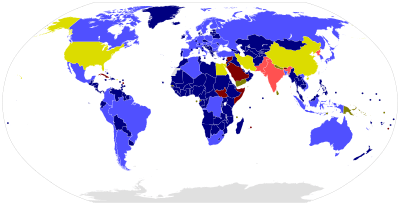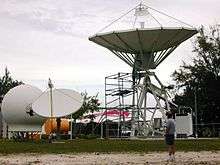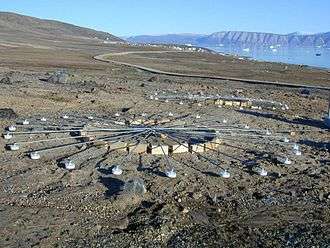Preparatory Commission for the Comprehensive Nuclear-Test-Ban Treaty Organization
The Preparatory Commission for the Comprehensive Nuclear-Test-Ban Treaty Organization, or CTBTO Preparatory Commission is an international organization based in Vienna, Austria, that is tasked with building up the verification regime of the Comprehensive Nuclear-Test-Ban Treaty Organization (CTBTO). The organization was established by the States Signatories to the Comprehensive Nuclear-Test-Ban Treaty (CTBT) in 1996.
 | |
 The Commission's headquarters are located at the Vienna International Centre. | |
| Abbreviation | CTBTO Preparatory Commission |
|---|---|
| Formation | 19 November 1996 |
| Founded at | United Nations Headquarters, New York City |
| Type | Intergovernmental |
| Purpose | Prepare for the entry into force of the Comprehensive Nuclear-Test-Ban Treaty. |
| Headquarters | Vienna International Centre Vienna, Austria |
| Coordinates | 48.234722°N 16.416944°E |
| Fields | Nuclear disarmament |
Membership (2017) | 184 Member States[1] |
Executive Secretary | |
Budget (2017) | $128,623,705[2] |
Staff (2017) | 277[2] |
| Website | ctbto.org |
Its main purpose is twofold: to promote the entry into force of the CTBT, and to establish a global verification regime in preparation for the Treaty's entry into force.[3]
As the CTBTO Preparatory Commission is an interim organization, it will be dissolved once the CTBT enters into force and will be replaced by the CTBTO, with all its assets being transferred to the CTBTO. This change will occur at the close of the first Conference of States Parties of the CTBT, which will take place when the Treaty has entered into force. For the Treaty to enter into force, the following states need to ratify the CTBT: China, Democratic People's Republic of Korea, Egypt, India, Iran (Islamic republic of), Israel, Pakistan and the United States of America. Entry into force will occur 180 days after these states ratify the Treaty.[3][4]
Organization
The Commission is composed of two main organs, the Plenary Body and the Provisional Technical Secretariat.[3]
Plenary Body
The Plenary Body, sometimes called the Preparatory Commission, is composed of all States Signatories of the CTBT.[5] The work of the Body is assisted by the following working groups:
- Working Group A
- Deals with budgetary and administrative matters.
- Working Group B
- Deals with the examination of verification issues.
- The Advisory Group
- Advises the Preparatory Commission on financial, budgetary and associated administrative matters.
Provisional Technical Secretariat (PTS)
The Provisional Technical Secretariat assists the Preparatory Commission in carrying out its activities, as well as working to fulfill its mandate.[5] The work of the Secretariat is divided amongst three main technical divisions:
- International Monitoring System Division
- International Data Centre Division and
- On-Site Inspection Division
Additionally, these technical divisions are supported by the Legal and External Relations Division and the Division of Administration.[3]
The Secretariat is headed by an Executive Secretary, the current of which is Lassina Zerbo of Burkina Faso.[3]
Membership

|
Annex 2, signed and ratified
Annex 2, signed
Annex 2, non-signatory
|
Not Annex 2, signed and ratified
Not Annex 2, signed
Not Annex 2, non-signatory
|
As of 2019 there are 184 Member States of the CTBTO Preparatory Commission, the latest of which to join was Tuvalu on 25 September 2018. Of these, 167 have ratified the Treaty. The latest state to ratify the Treaty was Thailand, on 25 September 2018.[1]
All States Signatories to the CTBT are automatically members of the CTBTO Preparatory Commission.[4][5]
Annex 2 States
Annex 2 States are those states that participated in the negotiations of the CTBT, and were also members of the Conference on Disarmament, which possessed nuclear power or research reactors at the time. In order for the CTBT to enter into force all 44 of these states must sign and ratify the Treaty.[6][7] The following are the Annex 2 States:[7]
| Annex 2 States |
|---|
| Algeria, Argentina, Australia, Austria, Bangladesh, Belgium, Brazil, Bulgaria, Canada, Chile, China*, Colombia, Democratic People's Republic of Korea*, Democratic Republic of the Congo, Egypt*, Finland, France, Germany, Hungary, India*, Indonesia, Islamic Republic of Iran, Israel*, Italy, Japan, Mexico, Netherlands, Norway, Pakistan*, Peru, Poland, Republic of Korea, Romania, Russian Federation, Slovakia, South Africa, Spain, Sweden, Switzerland, Turkey, Ukraine, United Kingdom, United States of America*, Vietnam |
| * Have not ratified |
Leadership
The following compose the leadership of the Preparatory Commission:[3]

| Name | Country | Position |
|---|---|---|
| Lassina Zerbo | Executive Secretary | |
| Maria Assunta Accili Sabbatini | Chairperson | |
| Alfredo Raul Chuquihuara Chil | Chairperson on Administration | |
| Joachim Schulze | Chairperson on Verification | |
| Michael Weston | Chairperson, Advisory Group | |
Verification regime

The Preparatory Commission has started building the global systems for the detection of nuclear tests required for the success of the CTBTO. The system consists of the following elements to verify that a nuclear test has occurred: the International Monitoring System, the International Data Centre, a Global Communications Infrastructure, Consultation and clarification, On-Site Inspection and Confidence-building measures.[11]
International Monitoring System (IMS)
The International Monitoring System consists of 337 facilities worldwide to monitor the planet for signs of nuclear explosions. This will include 321 monitoring stations, as well as 16 laboratories.[11] On 19 November 2018, the CTBTO announced that all 21 monitoring facilities located in Australia were completed "and sending reliable, high-quality data...in Vienna, Austria, for analysis."[12]
The System comprises:
- 170 seismic monitoring stations (50 primary + 120 auxiliary)[13]
- The seismic monitoring system monitors for underground nuclear explosions. These stations measure waves generated by seismic events that travel through the Earth. The data collected by these stations helps locate and distinguish a seismic event between naturally occurring events and man-made seismic events.
- The primary stations are online 24/7 and deliver seismic data to the International Data Centre (IDC) continuously and in real time.
- The auxiliary stations provide data upon request.
- 11 hydroacoustic monitoring stations (6 hydrophone + 5 T-Phase)[14]
- The hydroacoustic monitoring system monitors for underwater nuclear explosions. These stations measure waves generated by seismic events that travel through the ocean and help distinguish between naturally-occurring and man-made events. Date collected by these stations is transmitted to the IDC 24/7 in real time via satellite.
- The hydrophone stations are located underwater and use microphones to monitor changes in water pressure caused by sound waves, which can then be converted to measurable electric signals.
- The T-Phase stations are located on islands and monitor waterborne acoustic energy, i.e. waves, when it makes landfall.
- 60 infrasound monitoring stations[15]
- The infrasound monitoring system monitors for micro-pressure changes in Earth's atmosphere, which are caused by infrasonic waves. These waves have a low frequency and cannot be heard by human ears, and can be caused by nuclear explosions.
- The data collected by these stations helps locate and distinguish an atmospheric event between naturally occurring events and man-made events. This data is transmitted to the IDC 24/7 in real time.
- 96 radionuclide monitoring stations (80 stations + 16 laboratories)[16]
- The radionuclide monitoring system monitors the atmosphere for airborne radioactive elements. The presence of specific radionuclides provides unambiguous evidence of a nuclear explosion. Monitoring for radionuclides occurs 24/7.
- The radionuclide monitoring stations use air samplers to detect radioactive particles released from atmospheric explosions and/or vented from underground or under-water explosions. Forty of these stations are equipped with noble gas detection devices.
- The radionuclide laboratories are independent from the IMS and analyze samples only when their services are required. These laboratories analyze samples collected by the monitoring stations suspected of containing radionuclide materials that may have been produced by a nuclear explosions.
Global Communications Infrastructure (GCI)
The Global Communications Infrastructure transmits all data collected by the 337 IMS stations in real time to the IDC in Vienna, where it will be processed.[17] This data is transmitted via a network of six satellites and over 250 VSAT links.
Additionally, the GCI is used to transmit raw data from the IMS stations to Member States, as well as data bulletins from the IDC.
International Data Centre (IDC)
The International Data Centre collects, processes and analyzes data from the 337 IMS stations. It then produces data bulletins which are sent to the Member States. The IDC also archives all data and data bulletins in its computer center.[11][18]
Incoming data is used to register, locate and analyse events, with and emphasis on detecting nuclear explosions. Analysts review this data and prepare a quality-controlled bulletin to send out to the Member States. The IDC has sending out IMS station data and IDC data bulletins to Member States since 21 February 2000.[11]
Consultation and clarification
If a Member State feels that a date bulletin from the IDC implies a nuclear explosion, it can request a consultation and clarification process. This allows a State, through the Executive Council of the CTBTO, to request from another State clarification on a suspected nuclear explosion. A State that has received such a request has 48 hours to clarify the event in question.[11]
However, this process can only be triggered after the CTBT enters into force.
On-site inspection
The final verification measure under the CTBT is an on-site inspection. These inspections can only be requested by States Parties to the CTBT, and are launched in order to ascertain whether or not a nuclear explosion has been carried out. Once an on-site inspection has been requested the State Party in question cannot refuse to allow it to take place. Additionally, these inspections can occur regardless of the results of the consultation and clarification process.[11][19][20]
However, this process can only be triggered after the CTBT enters into force.
Confidence-building measures
In order to fine-tune the IMS network, and to build confidence in the system, Member States are advised to notify the CTBTO Technical Secretariat in the case of any chemical explosion using more than 300 tonnes of TNT-equivalent blasting material. This ensures that there is no misinterpretation of verification data and that they are not accused of performing nuclear explosion.[11]
However, this is done on a voluntary basis.
Preparatory Commission's data
While the data collected by the Preparatory Commission can be used to detect nuclear tests, it can also be used by civil society, as well as for scientific uses. This information is particularly useful in the field of disaster mitigation and early warning. In 2006, the CTBTO started providing seismic and hydroacoustic data directly to tsunami warning centers. As of 2012, data is shared with tsunami warning centers in eight countries, mainly in the Indo-Pacific region.[21]
Throughout the Fukushima Daiichi nuclear disaster of March 2011, the CTBTO’s radionuclide stations tracked the dispersion of radioactivity on a global scale.[22] More than 1600 detections of radioactive isotopes from the crippled nuclear reactor were picked up by over 40 CTBTO radionuclide monitoring stations. The CTBTO shared its data and analysis with its 184 Member States, as well as international organizations and some 1,200 scientific and academic institutions in 120 countries.[23]
The CTBTO also recorded the infrasound produced in the atmosphere by the meteor explosion over Chelyabinsk, Russia in 2013. Seventeen stations around the world, including one in the Antarctic, recorded the event as the infrasound reverberated around the world multiple times.[24]
Recordings from CTBTO hydrophones was analyzed to determine an impact location for Air France Flight 447 and Malaysia Airlines Flight 370, both of which were lost without a known crash site. No data was detected in the event of Flight 447, even after it was reassessed once the location of the wreckage was known.[25] As of July 2014, Flight 370 remains missing with no known crash site or confirmed debris. Since the only evidence for Flight 370's final resting site comes from an analysis of its satellite transmissions, which has resulted in an imprecise and very large search area, hydroacoustic recordings from CTBTO were analyzed to potentially determine and locate its impact with the Indian Ocean. Analysis of available hydroacoustic recordings (including those made by a CTBTO hydrophone located off Cape Leeuwin, Western Australia) identified one event which may be associated with Flight 370.[25][26][27]
Other potential civil and scientific applications include the use of CTBTO data and technologies in civil aviation and shipping and in climate change research.[28]
Verification regime in action
In the morning of 9 October 2006, North Korea set off a nuclear explosion. It detonated a nuclear device at a test site in the northeast of the country. The CTBTO’s global monitoring network detected the low yield explosion with 22 of its seismic stations. Within two hours of the explosion, CTBTO Member States received initial information about the time, location and magnitude of the blast.
Two weeks after the blast, a monitoring station at Yellowknife in northern Canada detected traces of the radioactive noble gas xenon in the air. The presence of xenon provides evidence that a nuclear explosion has taken place. This detection confirmed that the 2006 North Korean nuclear test was a nuclear explosion. Analysts at the CTBTO then used special calculations to backtrack the detected xenon to determine its source. The calculation indicated that the detected noble gas originated from North Korea.[29]
North Korea conducted a second nuclear test on 25 May 2009. Seismic data indicated an unusually large underground explosion. The blast took place only a few kilometers from where the first nuclear device had been detonated in 2006.
Considerably more seismic stations registered the explosion in 2009 than in 2006. This was due to the greater magnitude of the blast and the higher number of monitoring stations in operation. Two hours after the test, the CTBTO presented initial findings to its Member States. The information available also helped analysts to identify a far smaller area as the location of the explosion. In 2009 the estimated area covered 264 km2 compared to 880 km2 in 2006.[30][31]
In the morning of 12 February 2013 (at 02.57.51 UTC), the CTBTO monitoring system detected another unusual seismic event in North Korea, which measured 4.9 in magnitude. Later that morning, North Korea announced that it had conducted a third nuclear test. The event was registered by 94 seismic stations and two infrasound stations in the CTBTO’s network. The first automatic analysis of location, time and magnitude was made available to Member States in less than an hour.[32] The analysed data showed the event’s location (with a certainty of about +/- 8.1 km) was largely identical with the two previous nuclear tests (Lat.: 41.313 degrees north; long.: 129.101 degrees east). As with the two previous nuclear tests, the signal was emitted from close to the surface.[33]
The CTBTO radionuclide network later made a significant detection of radioactive isotopes of xenon - xenon-131m and xenon-133 - that could be attributed to the nuclear test. The detection was made at the radionuclide station in Takasaki, Japan, located at around 1,000 kilometres, or 620 miles, from the North Korean test site. Lower levels were picked up at another station in Ussuriysk, Russia.[34][35] Using Atmospheric Transport Modelling, which calculates the three-dimensional travel path of airborne radioactivity on the basis of weather data, the North Korean test site was identified as a possible source for the emission.[36][37]
On June 22/23 2020 radionuclide stations in and near Stockhom, Sweden detected unusually high levels of caesium-134, caesium-137 and ruthenium-103 and and around the Baltic Sea. [38]
References
- "Status of Signature and Ratification". Preparatory Commission for the Comprehensive Nuclear-Test-Ban Treaty Organization. Preparatory Commission for the Comprehensive Nuclear-Test-Ban Treaty Organization. 25 September 2018. Retrieved 29 January 2019.
- Preparatory Commission for the Comprehensive Nuclear-Test-Ban Treaty Organization (July 2018). Annual Report 2017 (PDF) (Report). Provisional Technical Secretariat of the Preparatory Commission for the Comprehensive Nuclear-Test-Ban Treaty Organization. Retrieved 29 January 2019.CS1 maint: uses authors parameter (link)
- "Establishment, Purpose and Activities". Preparatory Commission for the Comprehensive Nuclear-Test-Ban Treaty Organization. Preparatory Commission for the Comprehensive Nuclear-Test-Ban Treaty Organization. n.d. Retrieved 29 January 2019.
- "Preparatory Commission for the Comprehensive Nuclear-Test-Ban Treaty Organization (CTBTO Preparatory Commission)". Nuclear Threat Initiative. Nuclear Threat Initiative. 25 September 2017. Retrieved 29 January 2019.
- "Composition and Structure". Preparatory Commission for the Comprehensive Nuclear-Test-Ban Treaty Organization. Preparatory Commission for the Comprehensive Nuclear-Test-Ban Treaty Organization. n.d. Retrieved 29 January 2019.
- "Glossary". Preparatory Commission for the Comprehensive Nuclear-Test-Ban Treaty Organization. Preparatory Commission for the Comprehensive Nuclear-Test-Ban Treaty Organization. n.d. Retrieved 29 January 2019.
- "Comprehensive Nuclear-Test-Ban Treaty (CTBT)". Nuclear Threat Initiative. Nuclear Threat Initiative. 31 July 2018. Retrieved 29 January 2019.
- "Appointment of the Executive Secretary: Terms and Conditions. Decision". Preparatory Commission for the Comprehensive Nuclear-Test-Ban Treaty Organization. Preparatory Commission for the Comprehensive Nuclear-Test-Ban Treaty Organization. 3 March 1997. Retrieved 29 January 2019.
- Thunborg, Annika (1 August 2005). "Ambassador Tibor Toth Becomes New Executive Secretary of the Preparatory Commission for the CTBTO". Preparatory Commission for the Comprehensive Nuclear-Test-Ban Treaty Organization. Preparatory Commission for the Comprehensive Nuclear-Test-Ban Treaty Organization. Retrieved 29 January 2019.
- Mützelburg, Thomas (1 August 2013). "Executive Secretary Lassina Zerbo Takes Office, Travels to China". Preparatory Commission for the Comprehensive Nuclear-Test-Ban Treaty Organization. Preparatory Commission for the Comprehensive Nuclear-Test-Ban Treaty Organization. Retrieved 29 January 2019.
- "Overview of the Verification Regime". Preparatory Commission for the Comprehensive Nuclear-Test-Ban Treaty Organization. Preparatory Commission for the Comprehensive Nuclear-Test-Ban Treaty Organization. n.d. Retrieved 30 January 2019.
- Dr Lassina Zerbo (19 November 2018). "Australia completes its monitoring stations in the Global Network to detect nuclear tests". CTBTO. Archived from the original on 19 November 2018. Retrieved 25 July 2019.
- "Seismic Monitoring". Preparatory Commission for the Comprehensive Nuclear-Test-Ban Treaty Organization. Preparatory Commission for the Comprehensive Nuclear-Test-Ban Treaty Organization. n.d. Retrieved 30 January 2019.
- "Hydroacoustic Monitoring". Preparatory Commission for the Comprehensive Nuclear-Test-Ban Treaty Organization. Preparatory Commission for the Comprehensive Nuclear-Test-Ban Treaty Organization. n.d. Retrieved 30 January 2019.
- "Infrasound Monitoring". Preparatory Commission for the Comprehensive Nuclear-Test-Ban Treaty Organization. Preparatory Commission for the Comprehensive Nuclear-Test-Ban Treaty Organization. n.d. Retrieved 30 January 2019.
- "Radionuclide Monitoring". Preparatory Commission for the Comprehensive Nuclear-Test-Ban Treaty Organization. Preparatory Commission for the Comprehensive Nuclear-Test-Ban Treaty Organization. n.d. Retrieved 30 January 2019.
- "The Global Communications Infrastructure". Preparatory Commission for the Comprehensive Nuclear-Test-Ban Treaty Organization. Preparatory Commission for the Comprehensive Nuclear-Test-Ban Treaty Organization. n.d. Retrieved 30 January 2019.
- "History of the International Data Centre". Preparatory Commission for the Comprehensive Nuclear-Test-Ban Treaty Organization. Preparatory Commission for the Comprehensive Nuclear-Test-Ban Treaty Organization. n.d. Retrieved 30 January 2019.
- "The Final Verification Measure". Preparatory Commission for the Comprehensive Nuclear-Test-Ban Treaty Organization. Preparatory Commission for the Comprehensive Nuclear-Test-Ban Treaty Organization. n.d. Retrieved 30 January 2019.
- "CTBTO PrepCom Selects Five NNSA Experts as On-Site Inspection Surrogate Inspector Trainees". National Nuclear Security Administration. United States Department of Energy. Retrieved 30 January 2019.
- "CTBTO Highlight 2010: France Inks Agreement with CTBTO to Receive Tsunami Warnings". CTBTO Preparatory Commission. Retrieved 15 May 2012.
- "The 11 March Japan Disaster". CTBTO Preparatory Commission. Retrieved 15 May 2012.
- "CTBTO Press Release 2011: CTBTO to Share Data with IAEA and WHO". CTBTO Preparatory Commission. Retrieved 15 May 2012.
- Russian Fireball Largest Ever Detected by CTBTO’s Infrasound Sensors, Vienna, 18 February 2013.
- Molko, David; Ahlers, Mike; Marsh, Rene (4 June 2014). "Is mystery underwater sound the crash of Flight 370?". CNN. Retrieved 6 July 2014.
- Wolz, Susanna (4 June 2014). "Curtin researchers in search for acoustic evidence of MH370". Curtin University. Retrieved 6 July 2014.
- Butler, Declan (11 June 2014). "Sound clue in hunt for MH370". Nature. 510 (7504): 199–200. doi:10.1038/510199a. PMID 24919903.
- "Potential Civil and Scientific Applications of CTBT Verification Data and Technologies". CTBTO Preparatory Commission. Retrieved 15 May 2012.
- "CTBTO Highlight 2007: The CTBT Verification Regime Put to the Test". CTBTO Preparatory Commission.
- "CTBTO Press Release 2009: CTBTO's Initial Findings on the DPRK's 2009 Announced Nuclear Test". CTBTO Preparatory Commission.
- "CTBTO Highlight 2009: Experts Sure about Nature of the DPRK Event". CTBTO Preparatory Commission.
- "CTBTO Press Release 2013: On the CTBTO's detection in North Korea". CTBTO Preparatory Commission.
- "Update on CTBTO findings related to the announced nuclear test by North Korea". CTBTO Preparatory Commission.
- "Gases "consistent with" North Korea's February test found: nuclear body". Reuters.
- "SIPRI Yearbook 2014: Nuclear explosions, 1945–2013". Stockholm International Peace Research Institute (SIPRI). Archived from the original on 17 April 2015.
- "Video: CTBTO Detects Radioactivity Consistent with North Korean Nuclear Test, announced Feb 2013". CTBTO Preparatory Commission.
- "Media questions / answers on radionuclide detection". CTBTO Preparatory Commission.
- https://www.reuters.com/article/us-nuclear-particles-baltic-idUSKBN23X2TN

